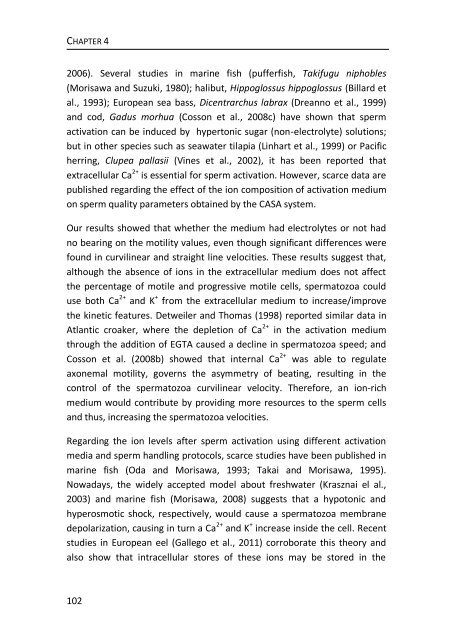chapter 3 - RiuNet
chapter 3 - RiuNet
chapter 3 - RiuNet
Create successful ePaper yourself
Turn your PDF publications into a flip-book with our unique Google optimized e-Paper software.
CHAPTER 4<br />
2006). Several studies in marine fish (pufferfish, Takifugu niphobles<br />
(Morisawa and Suzuki, 1980); halibut, Hippoglossus hippoglossus (Billard et<br />
al., 1993); European sea bass, Dicentrarchus labrax (Dreanno et al., 1999)<br />
and cod, Gadus morhua (Cosson et al., 2008c) have shown that sperm<br />
activation can be induced by hypertonic sugar (non-electrolyte) solutions;<br />
but in other species such as seawater tilapia (Linhart et al., 1999) or Pacific<br />
herring, Clupea pallasii (Vines et al., 2002), it has been reported that<br />
extracellular Ca 2+ is essential for sperm activation. However, scarce data are<br />
published regarding the effect of the ion composition of activation medium<br />
on sperm quality parameters obtained by the CASA system.<br />
Our results showed that whether the medium had electrolytes or not had<br />
no bearing on the motility values, even though significant differences were<br />
found in curvilinear and straight line velocities. These results suggest that,<br />
although the absence of ions in the extracellular medium does not affect<br />
the percentage of motile and progressive motile cells, spermatozoa could<br />
use both Ca 2+ and K + from the extracellular medium to increase/improve<br />
the kinetic features. Detweiler and Thomas (1998) reported similar data in<br />
Atlantic croaker, where the depletion of Ca 2+ in the activation medium<br />
through the addition of EGTA caused a decline in spermatozoa speed; and<br />
Cosson et al. (2008b) showed that internal Ca 2+ was able to regulate<br />
axonemal motility, governs the asymmetry of beating, resulting in the<br />
control of the spermatozoa curvilinear velocity. Therefore, an ion-rich<br />
medium would contribute by providing more resources to the sperm cells<br />
and thus, increasing the spermatozoa velocities.<br />
Regarding the ion levels after sperm activation using different activation<br />
media and sperm handling protocols, scarce studies have been published in<br />
marine fish (Oda and Morisawa, 1993; Takai and Morisawa, 1995).<br />
Nowadays, the widely accepted model about freshwater (Krasznai el al.,<br />
2003) and marine fish (Morisawa, 2008) suggests that a hypotonic and<br />
hyperosmotic shock, respectively, would cause a spermatozoa membrane<br />
depolarization, causing in turn a Ca 2+ and K + increase inside the cell. Recent<br />
studies in European eel (Gallego et al., 2011) corroborate this theory and<br />
also show that intracellular stores of these ions may be stored in the<br />
102
















